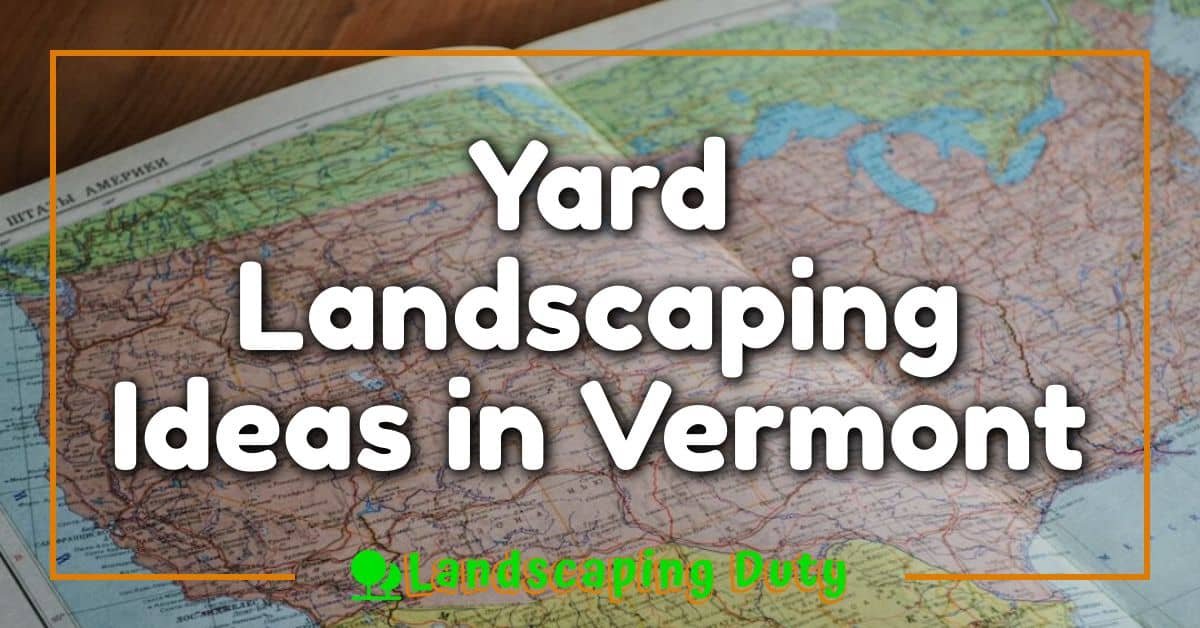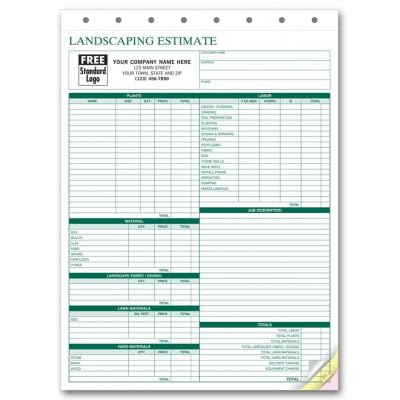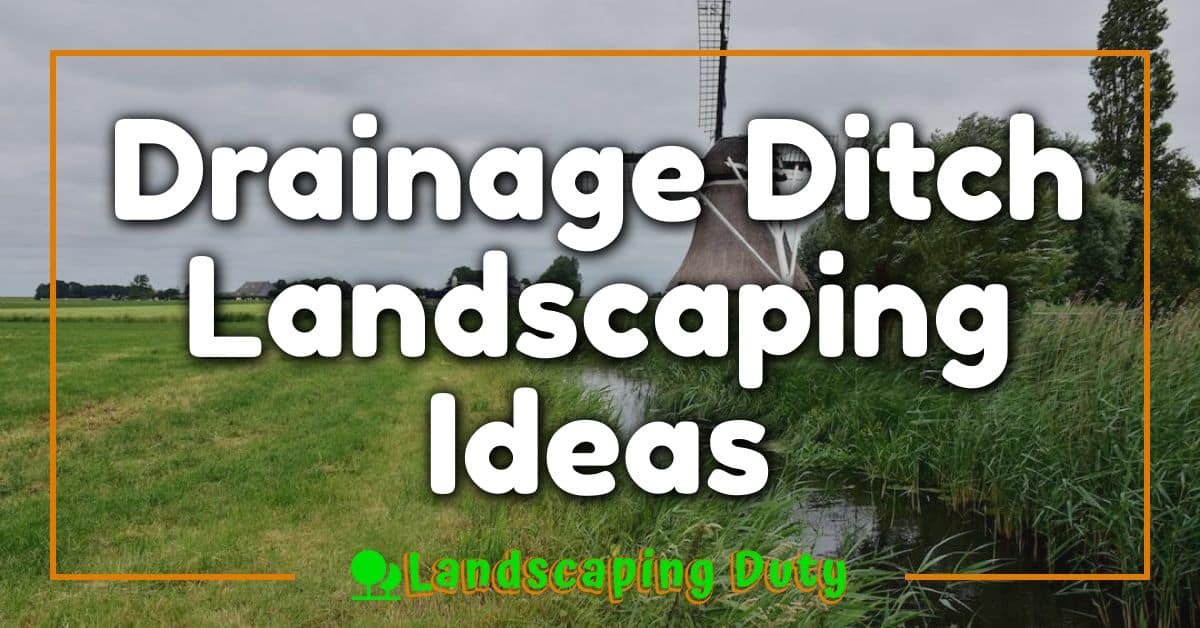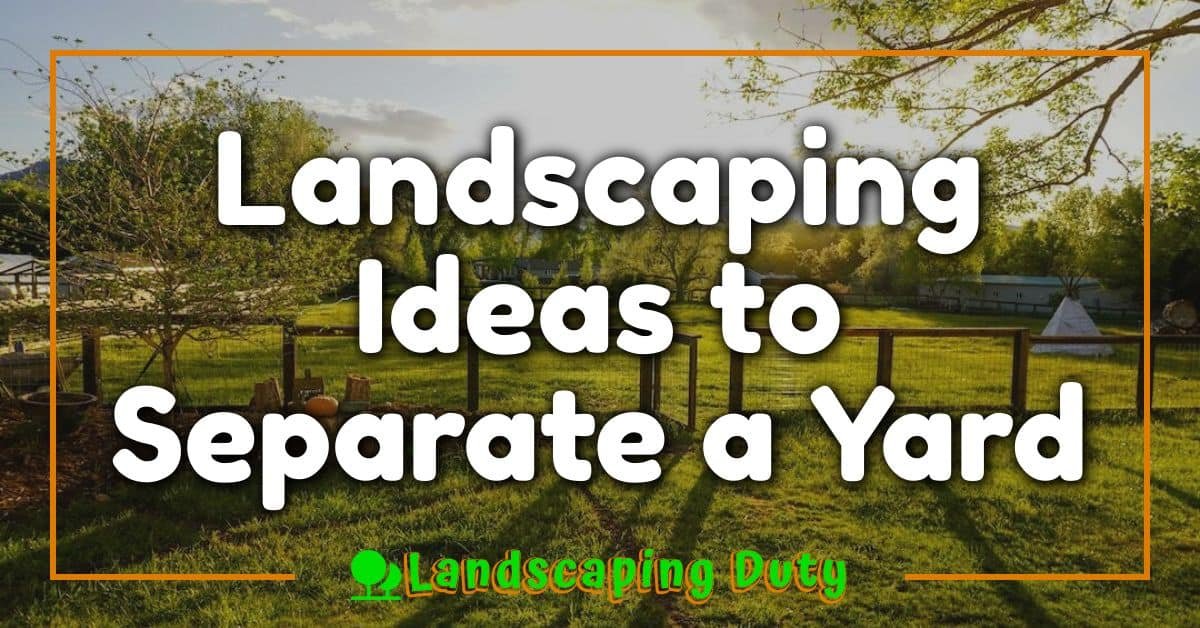Looking to spruce up your Vermont yard? Let’s dive into some local landscaping ideas. Nestled in the New England region, Vermont is known for its distinct four-season climate and picturesque landscapes – from majestic mountains and dense forests to serene lakes and beautiful meadows. You’re fortunate to be living in such a verdant state! With some creativity and planning, you can turn your yard into a breathtaking extension of the Green Mountain State’s natural beauty.

Imagine walking out to a garden that reflects the changing seasons, filled with native plant species flourishing in harmony. Or picture lounging on a rustic stone patio, sipping hot cocoa while watching fall leaves carpet your lawn with vibrant hues. It’s not just about aesthetics though; smart landscaping can also increase your home’s value, reduce maintenance costs, and create inviting outdoor spaces for relaxation or social gatherings.
Now let’s get down to business: what exactly should you consider when planning your Vermont landscape project? First off, understanding your specific climate zone is crucial as it influences which plants will thrive best. Also important are factors like soil type, sunlight exposure, water availability – all these will determine the success of your endeavor. Stay tuned as we explore more detailed tips and tricks to help transform your yard into an idyllic Vermont haven.
Understanding Vermont’s Climate for Landscaping
If you’re itching to get your hands dirty and spruce up your yard, getting a good grasp of Vermont’s unique climate is a great place to start. It’s no secret that this northern gem experiences all four seasons in full force, each with its own quirks and features that can impact your landscaping efforts.
Winter in Vermont can be pretty harsh; snow blankets the state from late November until well into March. But don’t let this chill you to the bone! There are plenty of hardy plants that thrive in these cold conditions. Think Snowdrops, Winter Jasmine or even Holly bushes – they’ll not only survive but add some much-needed color to your white winter landscape.
As the ice melts away, spring breathes new life into Vermont. This is when your garden starts waking up from its long winter nap – it’s also an ideal time to plant bulbs like Tulips and Daffodils. They’ll pop up just as temperatures begin warming, ushering in a burst of color and cheer!
Summers here are warm without being excessively hot which is perfect for growing vegetables like tomatoes, peppers or zucchini right there on your patch of green! And let’s not forget about fall; it’s pretty spectacular with foliage changing colors and painting landscapes with hues of reds, yellows and oranges.
So whether you’re looking at turning your backyard into a colorful flower oasis or planning on growing veggies for fresh summer salads, understanding Vermont’s climate will go a long way towards successful gardening exploits. Just remember: every season brings something new to the table – embracing this reality will help make your yard look fabulous year-round!
Choosing the Right Plants for Your Vermont Yard
You’ve got your blueprint ready and you’re all excited to transform your yard into a green paradise. But wait, have you thought about which plants will thrive in the Vermont climate? Well, don’t worry! We’ve got you covered.
First off, let’s talk trees. As we all know, Vermont is famous for its abundant maple trees. And why not? They’re hardy, they provide excellent shade during summer and their fall foliage is simply breathtaking. If you want a relatively low-maintenance tree that’ll add character to your yard year-round, consider adding a Sugar Maple or Red Maple to your landscape.
What about shrubs? Well, there’s no shortage of them in Vermont either. You can choose from Boxwood shrubs (perfect for shaping), Lilacs with their intoxicating scent or even Hydrangeas if you’re after some vibrant color.
If it’s flowers you’re after then Black-Eyed Susans and Coneflowers are solid choices. They are perennials that can withstand the harsh winters and bloom beautifully during spring and summer.
Now let’s not forget ground cover plants like Creeping Phlox or Sweet Woodruff – they’ll make fantastic additions especially on slopes where grass may struggle to grow.
Keep in mind though that while these plants do well in our climate, they each have specific needs when it comes to sunlight exposure and soil type so be sure to do a little homework before making any decisions.
In short:
- Trees: Sugar Maple and Red Maple
- Shrubs: Boxwood, Lilac & Hydrangea
- Flowers: Black-Eyed Susan & Coneflower
- Ground Covers: Creeping Phlox & Sweet Woodruff
With these options at hand, creating an inviting outdoor space that brims with life throughout the year has never been easier! Just remember – right plant, right place. Happy landscaping!
Incorporating Native Vermont Flora in Your Landscape
Jumping into the world of landscaping, it’s important to remember that using native plants can make a huge difference. And here in Vermont, we’re lucky to have such a diverse selection right at our fingertips!
Why go native, you might ask? Well, not only do these plant species need less maintenance since they’re adapted to local conditions, but they also add a unique touch of authenticity to your yard. Plus, they attract beneficial insects and birds, contributing to a balanced ecosystem right outside your front door.
Think about adding some classic Vermont trees like Sugar Maples or White Birch. They’ll provide lovely shade during those hot summer months and come autumn? You’re in for an explosion of color as leaves change from green to vibrant hues of orange and red.
« Yard Landscaping Ideas in Rhode Island: Transform Your Outdoor Space Today Wyoming Xeriscape Ideas: Your Ultimate Guide to Water-Saving Landscaping »
Speaking about color burstiness, don’t forget flowering perennials like Black-Eyed Susans or Purple Coneflowers. These gems will bring pops of color that are sure to catch the eye. Here’s another tip: alternate between different types for an interesting layout!
| Plant Name | Season |
|---|---|
| Sugar Maple | Fall |
| White Birch | All Year |
| Black-Eyed Susan | Summer |
| Purple Coneflower | Late Summer / Fall |
If you’re more into shrubs than trees or flowers, consider planting Buttonbush or Winterberry holly which both offer great visual interest throughout the year. Can you imagine fluffy white balls from Buttonbush attracting butterflies or bright red berries on Winterberry holly catching winter snowflakes?
Now I hear ya! “But what if my yard is too shady?” Not a problem! Ferns like Lady Fern or Christmas Fern love cool shady spots and they’ll give your landscape a lush feel with their rich green fronds.
Remember folks – incorporating native Vermont flora isn’t just about creating a beautiful landscape. It’s about embracing the natural beauty that our lovely state has to offer while promoting biodiversity in your own backyard!
Sustainable Landscaping Practices in Vermont
Ever thought of giving your yard a makeover? Well, let’s dive into the world of sustainable landscaping practices that are making waves right here in Vermont.
Vermonters have always had a deep connection to nature and it’s no surprise that they’re leading the way when it comes to sustainable landscaping. It’s all about creating outdoor spaces that not only look great but also contribute positively to the environment. Sounds good, doesn’t it?
Now you’re probably wondering, “What exactly does this involve?” Let me break it down for you. Here are some practices commonly seen across our Green Mountain State:
- Native Plant Selection: By selecting plants native to Vermont, you’re ensuring they’ll thrive in your garden with minimal intervention. They’re adapted to local conditions and will attract beneficial insects and birds too.
- Water Conservation: Rain barrels and drought-resistant plants can significantly reduce water usage. After all, every drop counts!
- Natural Pest Control: Forget synthetic pesticides; introduce natural predators like ladybugs or use plant varieties resistant to pests.
- Composting: An oldie but goodie! Composting organic waste helps improve soil fertility while reducing landfill waste.
Now let’s talk numbers. According to a survey by the University of Vermont Extension, over 60% of respondents reported using composting methods while nearly half used mulch for weed control—proving that these techniques aren’t just buzzwords but actual practices adopted by many homeowners.
| Method Used | Respondents (%) |
|---|---|
| Composting | 62 |
| Mulching | 48 |
And there you have it! Your first glimpse into sustainable landscaping practices taking root (pun intended) in Vermont yards. So next time you step out into your yard, consider these environmental-friendly options—you won’t just be doing mother nature a favor but also adding an authentic Vermont touch to your landscape.
Creating a Wildlife-Friendly Yard in Vermont
Ever thought about how to draw more birds, butterflies, and bunnies into your backyard? Well, you’re not alone! Many Vermonters are looking for ways to make their yards more appealing to native wildlife. Here’s how you can create a wildlife-friendly yard right here in the beautiful Green Mountain State.
Start with selecting native plants. These are the species that have been in Vermont forever and which local critters have evolved alongside. They provide familiar food and shelter options for various animals. You’ll find plenty of these at your local nursery or garden center.
Next on the list is water sources. It’s no secret that all creatures need water to survive. So why not add a birdbath or a small pond? Not only will it be an instant hit with feathered visitors, but amphibians like frogs and salamanders might also take up residence.
Then there’s shelter. Birds need places to nest, squirrels need spots to hide their acorns, and insects need safe spaces too. Planting dense shrubs or setting up birdhouses can offer much-needed refuge for these critters.
Lastly don’t forget about winter! When everything freezes over in Vermont, providing food sources becomes even more important. Consider installing bird feeders filled with seeds or suet blocks to help them stay nourished during those chilly months.
Now isn’t this exciting? With just a few simple steps you could turn your yard into veritable wildlife paradise! And remember – always respect nature and keep human interference minimal when dealing with wildlife in your backyard.
Top Landscape Design Trends in Vermont
Vermont, the Green Mountain State, is a natural canvas for beautiful landscapes. But what’s trending when it comes to yard landscaping? Let’s delve into some of the hottest trends sweeping through Vermont’s backyards.
First up, we have native plants. They’re making a comeback in a big way! You see, these local species are not only adapted to Vermont’s climate but also support local wildlife like birds and bees. So, you’re not just creating an appealing yard; you’re contributing to your local ecosystem too!
Next on the list is sustainability. It’s not just about planting trees or recycling anymore; it’s about designing your whole garden in a sustainable manner. This includes using drought-tolerant plants (to save water), organic soil amendments (to avoid chemicals), and even installing solar-powered lights.
Let’s talk about outdoor living spaces now. More and more folks are extending their homes beyond four walls. Imagine having your morning coffee surrounded by lush greenery or hosting weekend barbecues under the stars – quite enticing, isn’t it? Outdoor kitchens, pergolas with cozy seating areas – they all make your backyard much more than just a garden.
Lastly, there’s edible gardening – growing fruits, vegetables, herbs right in your own backyard! It’s perfect if you’re into organic eating or love cooking with fresh ingredients. Plus nothing beats the satisfaction of harvesting produce from your own little patch!
So there you go – native plants, sustainability efforts, outdoor living spaces and edible gardens are shaping up to be game-changers in Vermont landscape design trends.
Maintaining Your Landscape Through Vermont Seasons
When you’re living in the beautiful state of Vermont, you’ll quickly realize that each season brings its own unique set of challenges and opportunities for your yard. Embracing the changing seasons can be a fulfilling experience, especially when it comes to maintaining your landscape.
Think about spring – it’s a time of rebirth and renewal. As your garden awakens from its winter slumber, you’ll want to get out there and begin prepping for the blooming months ahead. Cleaning up any remaining fall leaves, pruning back overgrown shrubs and trees, applying mulch to your flower beds – all these tasks will help kickstart your garden into growing mode.
Then comes summer, with its warm days perfect for lounging on a well-maintained lawn. This is when you’ll need to keep an eye out for signs of drought stress on your plants. Regular watering becomes crucial during this period but be mindful not to waterlog them as it can lead to root rot. Don’t forget about weeding either; those pesky weeds love the summer sun just as much as your plants do!
As autumn rolls in, so does the vibrant palette of fall colors that Vermont is famous for. It’s time to start thinking about preserving those stunning hues by collecting fallen leaves and composting them into nutrient-rich soil for next year’s growth cycle.
And finally winter arrives – snow covered landscapes create breathtaking views but also bring chilling temperatures which could potentially harm some plants if left unprotected. You might want to consider adding a layer of straw or other protective materials around vulnerable perennials.
Vermont’s distinct seasons will continue cycling through their natural rhythm year after year. Your job? Simply adapt with each change, making sure that every season adds something special to your landscape!
Conclusion: Bringing It All Together For Your Perfectly Designed Yard
So, you’ve made it! You’re now standing on the edge of creating your dream Vermont yard.
Remember, it’s all about balance and harmony. Your landscaping should blend seamlessly with your home’s architectural style while reflecting the natural beauty that is quintessentially Vermont.
Don’t forget to incorporate native plants – they’re not only beautiful but also resilient and easy to care for. Plus, they’ll provide a habitat for local birds and insects which will add another layer of life to your yard.
Think seasonally as well! A great Vermont yard is one that looks good all year round. So plan accordingly – consider planting spring bulbs, summer perennials, fall foliage trees… heck, even strategically placed evergreens can provide visual interest in the winter months.
And what about those hardscape elements? A stone pathway or rustic wooden bench can do wonders in tying your landscape design together while providing functional benefits at the same time.
Finally, remember this isn’t a race—it’s your space! Enjoy every moment spent bringing your vision to life. Whether you tackle it all at once or piece by piece over several seasons doesn’t really matter. What matters most is that you create an outdoor environment where you feel comfortable and connected with nature.
Your perfectly designed yard awaits – get out there and make it happen!











